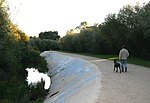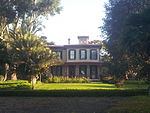La Goleta Gas Field

The La Goleta Gas Field (also known as the Goleta Gas Field and La Goleta Storage Field) is a natural gas field in unincorporated Santa Barbara County, California, adjacent to the city of Goleta. Discovered in 1929, and first put into production in 1932, it has been in continuous use ever since, producing approximately 12 billion cubic feet of gas. With production declining, the field was converted into a gas storage reservoir in 1941. As of 2016 it remains one of the four gas storage facilities maintained by Southern California Gas Company (SoCalGas), a division of Sempra Energy, with the others being Aliso Canyon, Honor Rancho and Playa del Rey. It is the oldest storage facility of the four and the third largest, with a maximum capacity of 21.5 billion cubic feet. The storage facilities are necessary to balance load for the over ten million customers of SoCalGas: during summer months, when gas usage is at a minimum, gas is pumped into the reservoirs; and in the winter when usage is high, gas is withdrawn. The La Goleta field serves the northern portion of SoCalGas's geographic range.In 2013 the field had 19 active gas wells and two observation wells. SoCalGas installed four new production wells in 2014-2015 after filing an Environmental Impact Report and obtaining a Land Use Permit from Santa Barbara County. The new wells pull gas from geologic units deeper than the existing storage reservoir, which is about 4,000 feet below ground surface.
Excerpt from the Wikipedia article La Goleta Gas Field (License: CC BY-SA 3.0, Authors, Images).La Goleta Gas Field
Geographical coordinates (GPS) Address Nearby Places Show on map
Geographical coordinates (GPS)
| Latitude | Longitude |
|---|---|
| N 34.4218 ° | E -119.8186 ° |
Address
93111
California, United States
Open on Google Maps






